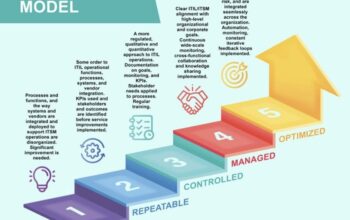Whether you’re a seasoned CIO embarking on a fresh challenge or a recently promoted executive in a new role, it’s important to get your first few months as a CIO right. Achieving success at the beginning of your leadership journey is challenging, but essential.
Your first 60 days are divided into two distinct themes: firstly, orientation, and reconnaissance, followed by envisioning and planning. I’ll also touch on going beyond the first 60 days where you’ll leverage the knowledge and strategies of your first two months and put your plan for change into action.
- 1-30 days – Orientation and reconnaissance
- 30-60 days – Vision and planning
- Beyond 60 days – Execution and change
0-30 days: Orientation and reconnaissance
So, you’ve arrived at your new assignment and introduced as the new CIO, typically with a positive and jubilant welcome—things are good. The organization is thrilled to have filled this important role and you’re becoming familiar with products, culture, services and organizational design.
The main elements you need to find clarity on within the next 30 days are:
- Your real boss
- Purpose and expectations of your role
- State of technology
- State of your team
- Your allies and influence
For an experienced, technically focused leader, some of these may seem obvious. Are you wondering why we’re even considering them? Welcome to you first lesson: as CIO – being a CIO is as much about people and relationships as it is about the technology.
1. Define your real boss
You may think you already know who your boss is, but I urge you to not take your direct manager at face value. The person you report to on the org chart is probably not the only one who evaluates your performance.
Your boss could be heavily influenced by others – let’s call these influences “shadow boss.” A shadow boss could be a shareholder, board member, or a more influential person than your direct line manager. The shadow boss may not undertake your performance review, but they’ll be influential to a level that they could enable or block initiatives you bring forward and affect other’s perception of your success.
Once you’ve identified your shadow boss, you need to identify what type of shadow boss they are. Are they a puppeteer who likes to control things whilst remaining out of sight, so that their own objectives are achieved? Or are they a true supporter of your direct line manager (and, thereby, you) and trust them emphatically?
Your boss could be heavily influenced by others – let’s call these influences “shadow boss.”
2. Establish your purpose and the expectations surrounding your role
Again, this may seem obvious, and you may be thinking that your purpose was clear in the job description or interview; however, organizations can poorly explain why your role is being filled. Is there a vacancy due to a previous CIO leaving? Is this a new role where there was no CIO previously in the company? Or is it the result of splitting responsibilities of a similar role such as a CTO? The reason your role exists matters.
Sometimes CIOs are hired to “fix a problem.” I recall one organization that struggled with delivery, and leadership couldn’t achieve reliable delivery times from their software development teams. The organization wanted someone to take responsibility for the solution delivery aspect of technology operations and solve that specific pain. Other, more mature organizations understand the need for technology services within the organization. They may hire a CIO to ensure that correct leadership exists for technology to be properly represented.
3. Determine the state of technology
Every CIO role involves managing technology, and so you should evaluate the state of technology you’ve inherited. Some organizations have invested appropriately in technology, and therefore your job is made easier, but underinvestment or mismanagement requires a more thorough investigation.
Regarding service delivery and technical operations, track your department against the ITIL framework (IT Information Library). Although you don’t have to be certified to ITIL or a similar standard, this baseline will help you define your organization’s maturity.
Assuming you’re also responsible for the development of and/or support of new technology products, a great benchmark measurement is Geoffrey Moore’s lifecycle of technology adoption[1]. Applying Geoffrey’s technology adoption lifecycle bell chart will help you quickly establish if the organization is making progress toward its product goals.
4. Review the state of your team
In my experience, understanding the state of your teams is commonly overlooked by CIOs. People management is the most important factor in your career failure or success, and some CIOs are frustrated that there is no single formula for leadership that achieves desired results. If you organize technical talent based on skills and strengths, you’ll create teams that work well together, overcome challenges and deliver on your behalf.
I’ve built and worked with world-class teams in the past. On these teams, each member knew their purpose, how they contributed to the department mission, and, most importantly, recognized their weaknesses and allowed other team members to demonstrate their strengths. This resulted in strong interdependencies, high trust and ferocious delivery, but it took several years to arrive at that point.
5. Find your allies and influence
Today’s CIO needs to forge strong relationships across the business. And so, you must establish who throughout the organization has a stake in your success. It’s important to understand how your peers view IT—some will see it as a cost or a key enabler and others will be indifferent. Forging strong relationships across the company increases your ability to create real change in the organization.
You may be wondering why I haven’t focused more on container technology, the state of core enterprise systems and platforms, and the type of database technology in use. To succeed as a CIO, you need to first understand the business and its dynamic—all the technology information will come to you eventually. The CIO must quickly establish themselves as a business executive and business stakeholder, otherwise you run the risk of self-isolating to the back room where IT is done. You want to avoid this outcome from the very first day you start your new role.
30-60 days: Vision and planning
By now you have a thorough understanding of the organization. Some of your preconceptions may have changed. You may be excited about the organization or you may have learned a few things you wish you knew during your interview. Whatever your impression now, it’s time prepare for your next 30 days. In this period, you need to develop a vision that inspires your teams and make a plan to reach your goals.
Days 30-60 are spent creating:
- Department priorities
- First line management team
- Mission clarity and adoption
1. Establish your priorities
By now you will know how IT is viewed within the organization and whether you’re being welcomed to the senior leadership table or kept in the back room. You’ll also know the key stakeholders determining how successful you’ll be in your role. Now it’s time to prioritize what’s important to you. These priorities will map directly to the purpose for your hire and the state of technology you spent reviewing in days 1-30.
For example, if you were hired to help launch a new product to the market, then you should not dedicate resources to increasing the company-wide usage of the ERP system. It’s necessary that you relentlessly set and deliver on your priorities—make it a fundamental part of your role.
2. Identify your first line management team
In most reasonably sized organizations, you need a team around you to deliver on goals and objectives. This core team is vital to creating time and bandwidth for you to engage across the company and embed yourself as a business executive. You won’t have these abilities if you’re managing every single project, dealing with every incident and approving every change yourself.
This is where you need a strong team with you. It can be difficult to identify your strongest technology leadership team after 30 or 60 days, so I recommend you leave yourself plenty of flexibility when establishing this team. You will need to make changes in the early years, and hiring may make sense to fill the competency gaps.
3. Clarify the mission and make sure everyone knows what it is and why it’s important
As CIO, you need to demonstrate leadership by declaring a department mission. It’s common for technical teams to be “order takers” who feel disconnected from business strategy. Your staff may fail to see how day-to-day IT work impacts the business’ overall success. So, it’s important to have a clear team mission, a mission that’s connected to day-to-day technical work and also linked to the overall organization.
The mission for your department needs to be meaningful, easy to understand and related to daily work. This statement doesn’t have to be perfect or permanent. In fact, I find a three year tenure for department missions to be effective. After three years, you can take stock of progress, re-base activities and ensure you keep pace with changes in the market. Of course, depending on the size and complexity of your organization, three years may be too long or too short for an effective mission, so adjust accordingly based on your needs.
BEYOND 60 DAYS: EXECUTE AND CHANGE
Now it’s time to put your mark on the organization. After spending 60 days assessing and planning, the execution of your priorities begins. You were most likely hired to effect change in the organization, so it’s important to demonstrate visible changes that stakeholders view as positive movement. This is going to be a very busy time as you drive multiple initiatives in parallel.
Start by getting the core team you identified in the previous 30 days engaged and committed to your plan. Establish a regular check-in cadence with this team, and ensure they all know their contribution to your role, the team’s responsibilities and the organization’s goals.
When you arrive at the point where you have a high performing team, are enabling the business, and contributing to a growing and successful enterprise, you’ll feel a great sense of achievement and satisfaction. However, this ongoing execution phase can present numerous and unexpected challenges. This is why it’s important to have clarity on the items we covered in the first 60 days, so you can utilize critical knowledge when something goes wrong.



